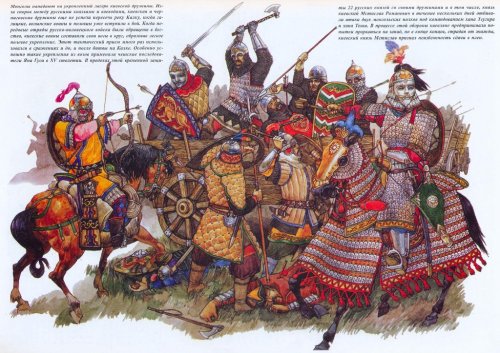When Batu, son of JOCHI and grandson of CHINGGIS KHAN, established his gold-hung ORDO (palace-tent) along the lower Volga, he followed Mongol precedents and required all Russian rulers personally to attend his court to inherit their thrones. From then on “going to the (Golden) Horde” (a word derived from the variant pronunciation horda of ordo) became a regular part of the Russian princes’ lives. Before 1259 several princes even made the vast journey to Mongolia itself, including Iaroslav (1190–1246), who died there, poisoned, his entourage believed. These audiences demanded delicate negotiation of religious and communal boundaries. The Russian clerics viewed common Mongol foods such as marmots and KOUMISS as unclean, a prohibition reflected in the chronicles’ excoriation of the “impure” and “accursed raw-eating Tatars.” Another issue was the ceremony of purification by fire with its attendant religious ceremonies, required of all those received in audience by the khan. In 1245 Daniel of Halych (d. 1264) performed the purification and drank fermented mare’s milk at Batu’s ordo without incident, but Michael of Chernihiv in 1246 refused the purification and was martyred. Such incidents soon became rare as the Jochid lords and the Russian princes adjusted to each other.
Daniel of Halych and Iaroslav’s son Alexander (1220–63) illustrate two of the possible responses to the Mongol conquest. Daniel toyed first with the idea of allying with Hungary and Poland and converting to Catholicism. Then he allied with still-pagan Lithuania. In the end, abandoned by all, he fled as the Mongols invaded Lithuania and destroyed the Russian fortifications in Halych and Volyn (1259–60). By contrast, Alexander Nevskii fought the Swedes (1240) and Teutonic Knights (1242) while at the same time winning the grand ducal throne from his brother Andrew in 1251 by submission to the Mongols.
From 1270 on the northern Russian princes appealed to the Mongol basqaqs (overseers) and troops to assist their particular ambitions. By the 1280s the emergence of the Jochid prince NOQAI west of the Dnieper as a challenger to the khan on the Volga encouraged a bloody rivalry between Alexander Nevskii’s sons Dmitrii (r. 1276–94) and Andrew (r. 1281–1304) for the position of grand prince. Four times between 1281 and 1293 armies from the khan plundered Suzdalia on behalf of Andrew, while Noqai’s armies backed Dmitrii. A similarly protracted feud broke out from 1278 to 1294 between brothers claiming the ducal throne of Rostov as well.
Eventually, many princes developed close relations with the Mongols, spending years at a time “at the Horde” and participating in the Horde’s wars. Several Russian princes received Mongol princesses as wives; even after the Horde’s Islamization the brides were always baptized before marriage. Following Mongol precedents, the khans granted complete tax exemption to the Orthodox Church and all its estates. In the church liturgy prayers for the “czar” (king/emperor) on the steppe replaced those for the “czar” in Byzantium. By the 1280s the khans also began to use the church hierarchs, particularly the metropolitan (who after 1240 resided at Vladimir in the northeast) and the bishop of Saray, as mediators between hostile princes. While the princes soon accepted Mongol rule as inevitable, Russian popular assemblies (veche) could still react unpredictably to Tatar envoys and/or troops entering Russian cities, rising up in Novgorod (1258), in several cities of Suzdalia (1262), in Rostov (1289), and in Tver’ (1327).
Numerous Russians also lived within the GOLDEN HORDE territories, in Saray and other cities on the Volga and on the steppe. Russian captives, along with Hungarians, OSSETES, and others, served in the ordos of their masters; many escaped and lived as bandits. Life on the steppe was hard for Christians, since the ban on eating Mongol food created a difficult choice between being a Christian and staying alive. Russians also served as levies in the Horde’s armies, and some appear to have reached high positions; in 1327 one Fedorchuk commanded the army dispatched by ÖZBEG KHAN (1313–41) to suppress the rebellion in Tver’. In the YUAN DYNASTY Russians taken captive during the first conquest to the east were even formed into a guards units in DAIDU (modern Beijing) in 1330.
While the Mongols worked through client rulers, they also established independent organs of rule. Basqaqs were appointed as supervisors to all the major cities and princes, with the “great basqaq” (veliki baskak) assigned to the grand prince of Vladimir. The Mongols conducted three censuses in the Russian lands: one in 1245–46 in the south and two in 1255–59 and 1273–74 covering the east and north. On the basis of this census, Russian households were enrolled in the DECIMAL ORGANIZATION and divided (exclusive of Novgorod) into 46 tümens, each nominally 10,000 households. As elsewhere in the MONGOL EMPIRE, subjects of the church were not included in the census. Servants directly attached to the Mongol ordos and postroad personnel were exempt from other taxes. The district of Tula, for example, was assigned to Taidula Khatun, wife of Özbeg.
At first the Mongols treated the Russians much like Siberian peoples, demanding furs, including sable and polar bear skins, from every person counted in the census. This demand for skins intensified the northern fur trade. By 1257 urban customs tax, or tamga (Mongolian, tamagha), and the iam (Mongolian, JAM), or postroad taxes, were also organized. Passing envoys and falconers were also free to levy contributions. The Mongols entrusted collection to tax farmers, at first Muslim merchants but later the princes themselves. In either case tax farming led in Russia, as elsewhere, to bidding wars between rival farmers for the right to collect the tax. People flocked to tax-exempt patrons, especially the Orthodox Church, but also ironically to the tax-exempt ORTOQ merchants who served as tax farmers. In 1284, for example, controversy arose when two cities near Kursk built by the Muslim basqaq (overseer) and tax farmer Ahmad drained population from the neighboring cities.
